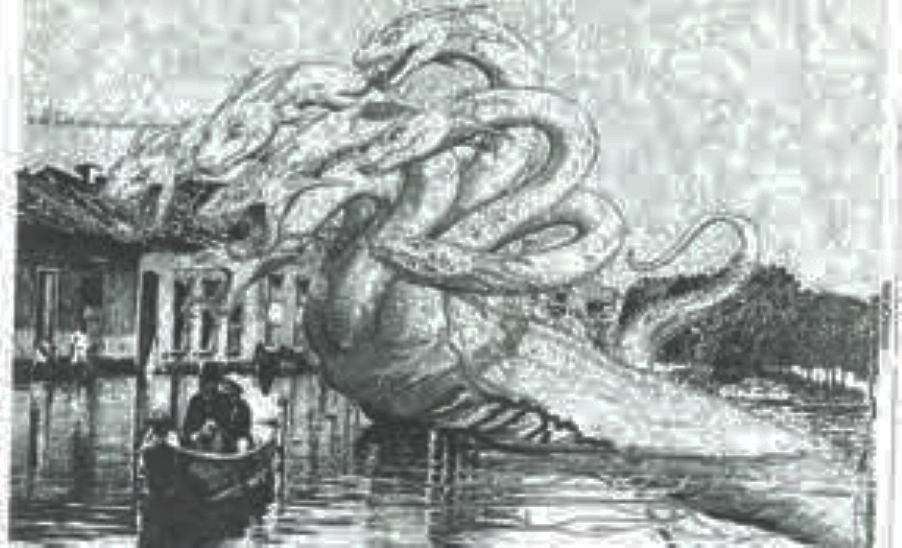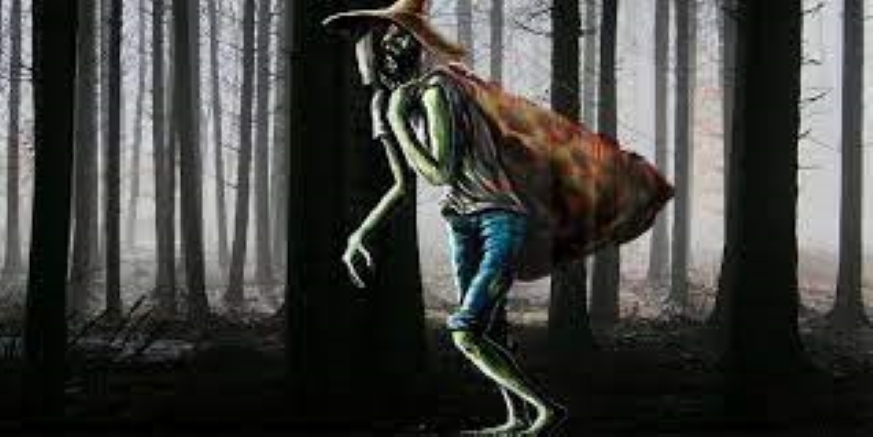I hope everyone is well. Today I am here to bring you an article dedicated to the mythological creatures of Venezuela, perhaps you never heard of these myths or legends in the corners of my land. They do not know how interesting and how much it covers these topics. Let's start with this article.

Criaturas mitológicas de Venezuela
"La Serpiente de siete cabezas"
The legend of the seven-headed serpent, or the Orinoco monster, this legend was told by the elders who resided here that under the middle stone, in the Orinoco, there was a seven-headed serpent, each one under different locations of the old town of Orinoco. In Ciudad Bolivar there is a saying that if the beast trembles, the city will sink into the river.
In the early 1900s, some believed that the Orinoco wreck was caused by a large snake. It was last seen in 1985, when harbor residents said they saw it causing large waves on the river.
During the 20th and early 20th centuries, three incidents were recorded near La Piedra. One was the sinking of a river ferry with several vehicles on board, and the other two were a car that fell off the Angostura Bridge and was swept into the area by the water. Neither the remains of the victims nor the vehicles were found, and at that time divers were dispatched to help ensure that it was impossible to reach the bottom of the river near the rock.
It is said that the Orinoco monster will reawaken from a deep sleep when the central stone is completely submerged, which is considered impossible as the stone is about 350 meters long and 100 meters wide.
However, in August 2018, the Orinoco River experienced a historic flood, with the stone in the middle about to be submerged.

"La Carona"
Nearby fishermen support the belief that there are mermaids in the Orinoco. At the mouth of the Caris river in the Orinoco, near Soledad, there is one of those Sirens known as the Carona and in the Upper Orinoco they are the dolphins that transform into mermaids to seduce sailors. To which the fishermen had to try to please to obtain a good fishing of lau lau and morocoto. If they failed, it would shake the boat with eddies and cause it to wreck.
A sailor who lives in La encaramada, told at the time that he had improved his luck with Carona when he discovered that this Nerelda from the Orinoco liked Anis, a very sweet Venezuelan liquor. So every time he went fishing he splashed his drink. Then the fishing of lau-lau and morococo was great.
In the Alto Orinoco they believe that in the depths of rivers and lagoons of the Amazon region there are enchanted cities that the indigenous people distinguish with the name of Temendagul belonging to the Mawari kingdom and that when a fisherman arrives at the fishing places and cannot remove from his mind to the woman he loves, it is most likely that a tonina will transfigure in her, seduce him and take him to the enchanted city.
According to later legends. The sirens, ashamed by the flight of Odysseus or by the victory of Orpheus, threw themselves into the sea and perished in Plato in The Republic places eight mermaids in the spheres that separate the world from the celestial spaces: Ovid in the Metamorphoses makes these beings accompany Persephone on his travels to Hades.

"La Sayona"
A legend dating from the 19th century tells how different types of women approach abusive men, covered with mulch, and speaking in a sweet and decorous way, then jump around their necks and leave them dead in the gutter. In many states they have different names in Mérida it is blonde and is called La Dientona, and in Trujillo La Taconera
Without a doubt it is the most popular legend in Venezuela. It tells the story of Melisa, a beautiful woman married to a good man who was incapable of hurting him. They both had a 9-month-old baby. Melisa used to bathe in the river, discovered by a malicious individual who spied on her very often
One day Melisa realized that she was being spied on, and asked the individual why he was doing it. To excuse himself, he lied to her saying that he wanted to warn her that her husband was unfaithful to her own mother. Melisa believed him and ran home, and dying of jealousy, set fire to the house with her husband and the baby inside.
Then he went to his mother's house to claim his infidelity, which told him that this was not true. She attacked her to death and before dying the other woman exclaimed: "I never lied to you and you committed the worst sin, for which I condemn you, sayona
The word Sayona refers to the white dress or batola (saya) worn by women. The stories tell that he usually appears to womanizing men, in the form of a seductive woman, or a common animal
By seducing them, asking for a cigarette, he changes his appearance to a hideous one with sharp teeth, and his victims die in horror or flee in terror. Men often go insane or die instantly, with only a few left alive to tell the story. The men who learned of the existence of La Sayona, when they traveled alone carried a blessed cross. It often hides in the streams, meadows, and plains of the Apure State. Today, La Sayona is said to be Satan's wife

"La novia de la carretera"
In Vargas, this Venezuelan legend has for years terrorized drivers who use the old Caracas-La Guaira highway. But why does this happen? What is the story behind this horror tale? Well, don't pick up any women on the old Caracas-La Guaira highway if you pass at night. If you feel a look on your neck from the back seat and you are traveling alone, do not look in the rear view mirror as the horror that you will encounter will not allow you to dodge the truck that is eating the lane at full speed
In the 1950s, when the current highway between Caracas and La Guaira did not exist in Venezuela, people used the "Old Highway". Many people say that the ghost of the bride appears.
There are many different versions of this myth, which makes sense considering the years gone by. In one version, it is said that a woman from Caracas named María José Cárdenas met the love of her life during a trip to the beaches of Vargas
The couple meets every Saturday until the date set for the wedding. Some say she has a small family and others say her mother disagreed with the marriage. That is why María took a taxi alone in Caracas to get to the party, but the car broke down. Desperate and fearful of not being able to arrive on time, she went out to ask other drivers to pick her up.
The vast majority ignored their request, until a car stopped and entered without hesitation. The driver was drunk and lost control on a curve. They both died in the accident. Since this tragic death, many tourists claim to have seen the soul of this woman on the side of the road.

Si es mucha tu curiosidad Aqui te invito a ver un capitulo de la “novia de la carretera” transmitido por rctv en la serie “archivos del mas alla”
"El silbón"
I am sure that you once heard about this legend of the Venezuelan lands. The entire population has heard about "El Silbón", there is no Venezuelan who is not paralyzed by his cursed whistle. The most sinister thing about this spectrum is that it announces its presence, but it is still useless, because if you have already heard it, you are doomed. He is perhaps ten feet tall and with his abnormally long legs he strides silently through the bush at dawn. He carries a bundle with the remains of those who have died in his hands.
It is said that it is the story of a spoiled young man, so spoiled by his parents without real knowledge of the word "respect", one day he wanted to eat "roast" which is the equivalent of liver, heart and intestines, and that is why his father, he decides to take his gun when he leaves home on a hunting trip.
The son tired of waiting so long for someone who had not yet arrived late at night, goes in search of his father with a shotgun in hand, after walking through the plain he finally manages to see but what would be his surprise? That his father had not been able to please his whim, which is why he decided without any other remedy to kill his father in order to remove the viscera from him and take them to his mother to be cooked, not without first putting the bones of the corpse in a small sack.
His mother tried to prepare the viscera for her son, but when she questioned the delay of her husband and the strangeness of the "roasts", she begins to question the spoiled boy, who confesses his sin, being cursed "for life", Trying to flee the place, he is chased by his brother Juan, who blew a chili pepper cap and "kicked" a dog named "Tureco", an animal that accompanies him until the end of time, biting his heels.
The elderly for a long time say that if you hear their whistle from afar, it is because it is close and if you hear it close, it is because it is far..

Diseño de mi portada fue hecho en Canva
Aqui les dejo el sitio donde recaude informacion para la realizacion de este post
Hasta mi proximo post hiveblogers!! Pueden dejar sus experiencias paranormales en los comentarios..